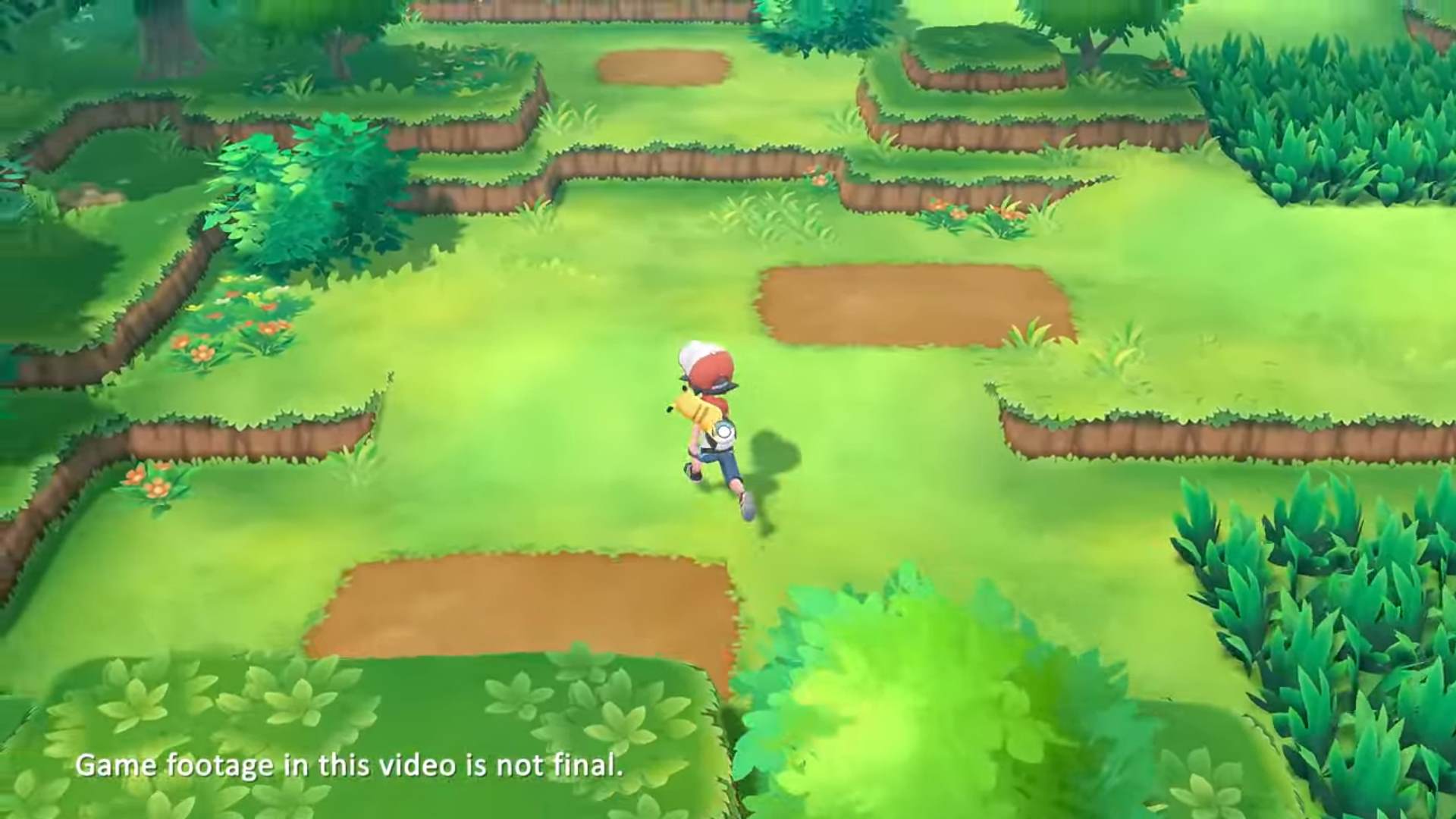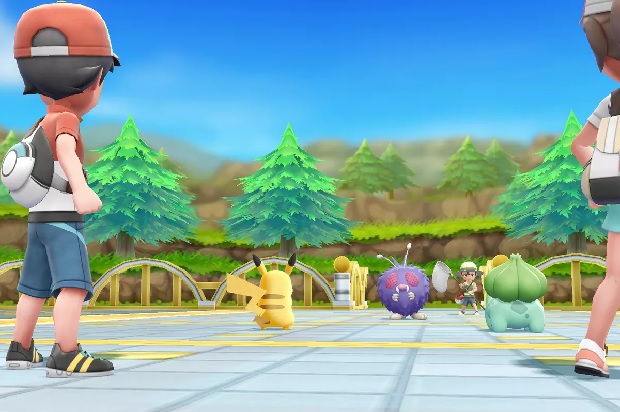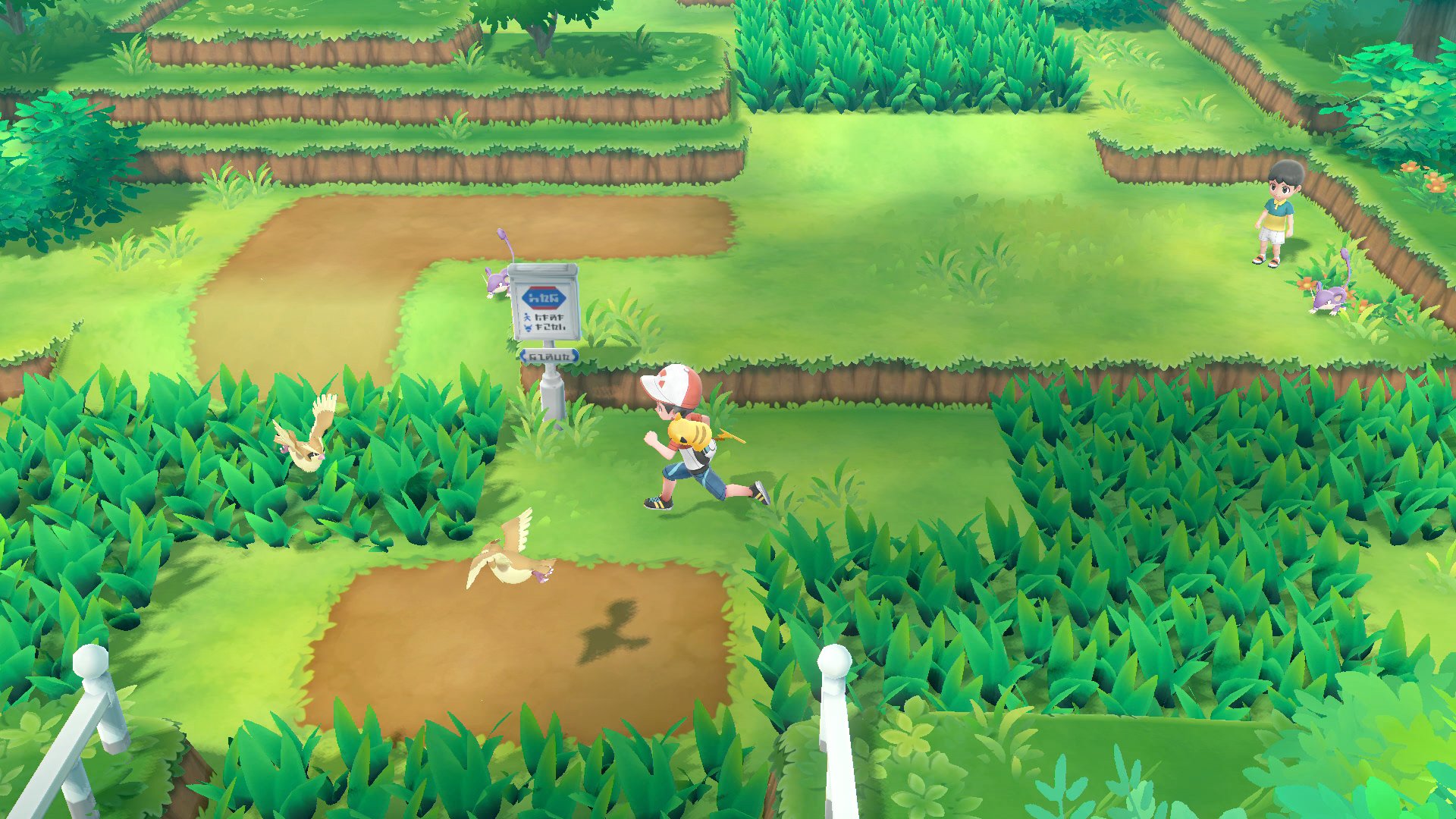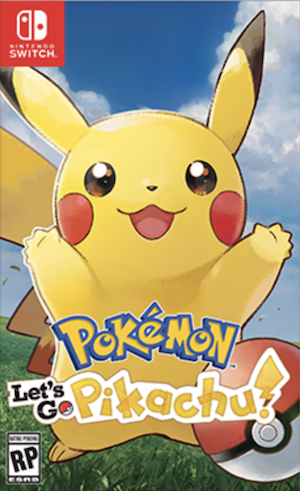
If the demo was a little more open, and I had more time to play, Pokemon Let’s Go, Pikachu! would have been my favorite game I played at this year’s E3 on the show floor. If you’re a fan of the handheld versions, and Pokemon GO for smart devices, Let’s Go, Pikachu! is definitely a welcome hybrid of both styles of games combined. I’ve been playing Pokemon since the first generation on GameBoy, and I’m currently in the middle of Pokemon Ultra Sun, so it may be my overwhelming enthusiasm for the Pokemon franchise, but I left this game with one of the biggest smiles on my face I had all E3.
The first thing the Nintendo representatives wanted me to do was to play with the Poke Ball controller before using a normal controller. Now, I’m not big on weird, cumbersome peripherals- though I will admit some of them are all right. The Poke Ball controller fits in either your right or left palm, as your index finger rests along the top (or red half of the ball) along a hidden A button, and your thumb rests on the Poke Ball’s white activate button (the center of the Poke Ball located between the red-half top and white-half bottom), which also doubles as a single analog stick and the B button. It feels very awkward, at first. Like when you get a new console and the controller is completely different from last generation’s. You have to get used to it. But oddly enough, I got used to it very quickly.
In no time at all, I was ready to play Pokemon, (on a TV!) with a Poke Ball controller in hand. The game starts out with selecting a trainer, Boy or Girl with a few variations, including aesthetics and choosing your name. We’ve learned that there are options for customizing your Pokemon, too, but that wasn’t part of this demo. As the name refers, Pikachu (or Eevee in the case of Let’s Go, Eevee!) will be on your shoulder from the start. You can go into the wild and increase your Pokemon collection, letting it grow with more monsters to battle with.
The game opens up to the insantly familiar world of the Kanto region- for veterans of the Pokemon series, you’ll recognize this region as the land from the very first Pokemon game. Unfortunately, there wasn’t much to do in the demo except run around a portion of the famous Viridian Forest. Rest assured, the graphics of current generation Pokemon games, such as Ultra Sun and Ultra Moon, carry over to the console version brilliantly, with a big boost in sharpness and resolution. Viridian Forest is laid out and designed with the idea of the handheld games in mind: clear dirt paths sometimes covered in tall grass, with trees everywhere, and all from an isometric point-of-view. You’ll instantly recognize the cartoon/kid friendly graphics and bright colors, and if you’re like me, it will take you all the way back to that very first game instantly.
The biggest difference I noticed from the handheld and the console version is that Pokemon aren’t just waiting to pounce from the tall grass any longer – though that is where they still congregate for the most part – but can now roam freely on the dirt roads, as well. It’s also important to note that randomly generated battles are not part of this game, or at least this part of the demo. All Pokemon are visible in the overworld, and you can avoid or go into battle with any of them at any time. Some Pokemon are passive and will just stay where they are, but some will follow you a bit, trying to entice you into a battle. Some locations can only be accessed by walking through the tall grass, and as I mentioned, Pokemon are mostly holed up in the tall grass, making avoiding battles altogether not too easy.
Anyway, I entered into a battle, with Pikachu leading the charge. The first thing I noticed in battle was how similar the layout is to Pokemon GO. A small animation of the enemy Pokemon pops up – in this particular case, a Kakuna. The enemy Pokemon takes the far side of the screen, as I face it from my side. You’ll see familiar options to choose from (if you’ve played Pokemon GO), Berries, and Run. Selecting Items then selecting a Razz Berry (as Pokemon GO fans should remember, that allows wild Pokemon to be less aggressive, making hem easier to catch) allowed me to throw a Berry for this wild Pokemon to eat.
Then I opted for another option on the battle system: Poke Ball. It’s time to catch this little Pokemon and add it to my team since it’s more mellow and easier to catch now. In Let’s Go, Pikachu!, when using the Poke Ball controller, you actually flick the ball like an underhand toss… without actually letting go of the ball, if you can help it (there’s a wrist strap included in case that happens). The way this plays out is similar to Pokemon GO, with the ability to actually throw a ball, instead of just pressing a button alone. The in-game Poke Ball will fly out and land on the Pokemon if you throw it with precision, but can also miss the Pokemon all together- again, similar to Pokemon GO.
After a few struggles by the Kakuna to escape the Poke Ball, I caught it and immediately held the Poke Ball up to my ear, and heard a faint call that was indubitably Kakuna’s Pokemon call. The Poke Ball will play the sounds of the Pokemon you capture, which adds that little bit of magic that Nintendo always seems to capture. Not only that, but you can take the Poke Ball controller with you and level up your Pokemon on the go as you walk. Anyway, the stat screen pops up with the Pokemon I captured and all of its information for battling and collection purposes, and it’s added to my team.
Then it’s back on the road in Viridian Forest. This time, against other trainers who are scattered throughout the forest, as you’d find in every one of the core handheld games. Of course these trainers are just AI and have nothing more to offer than a one-time battle. Battles with trainers are similar to wild Pokemon encounters you’ll have when walking through the tall grass. The only exceptions compared to wild encounters are that you can actually battle trainers. Trainers’ Pokemon are usually a bit tougher than wild ones because their skills are being honed by their trainer. After a quick win with a few of Pikachu’s electric attacks and taking the trainer down, I pretty much did everything there was to do within the demo. The location was small, but the experience was big.
With the combination of Pokemon GO and the handheld core games, Let’s Go, Pikachu! is looking like an instant-classic game I can see myself sinking hours and hours into. Not once during my session did I want to try the regular Switch controllers. The Poke Ball controller was just that much fun to use, and it really adds to the experience. After about 15 minutes of playing, I told the Nintendo representatives, “This is it! This is the Pokemon game we’ve all been asking for on a home console.” Then I wondered, why did it take so many years for Nintendo to finally do this?


















